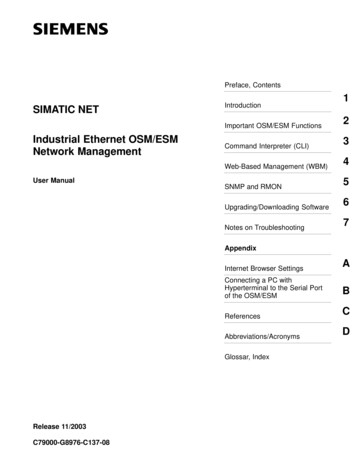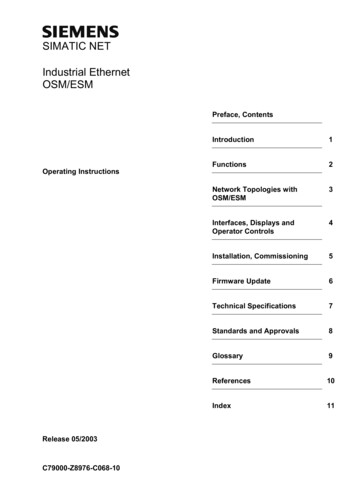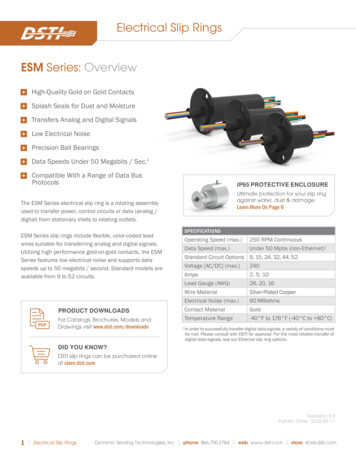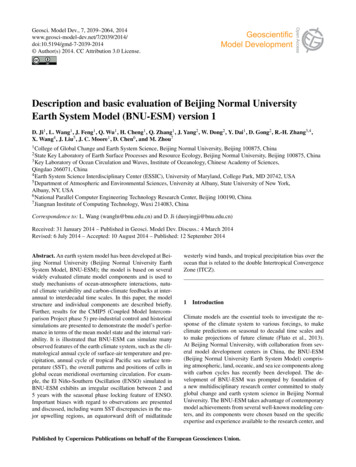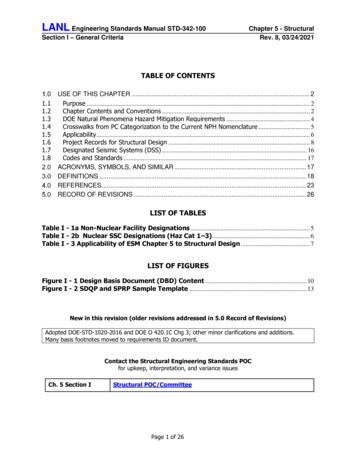
Transcription
LANL Engineering Standards Manual STD-342-100Section I – General CriteriaChapter 5 - StructuralRev. 8, 03/24/2021TABLE OF CONTENTS1.11.21.31.41.51.61.71.8USE OF THIS CHAPTER . 2Purpose . 2Chapter Contents and Conventions . 2DOE Natural Phenomena Hazard Mitigation Requirements . 4Crosswalks from PC Categorization to the Current NPH Nomenclature . 5Applicability. 6Project Records for Structural Design . 8Designated Seismic Systems (DSS) . 16Codes and Standards . 17ACRONYMS, SYMBOLS, AND SIMILAR . 17DEFINITIONS . 18REFERENCES . 23RECORD OF REVISIONS . 26LIST OF TABLESTable I - 1a Non-Nuclear Facility Designations . 5Table I - 2b Nuclear SSC Designations (Haz Cat 1–3). 6Table I - 3 Applicability of ESM Chapter 5 to Structural Design . 7LIST OF FIGURESFigure I - 1 Design Basis Document (DBD) Content . 10Figure I - 2 SDQP and SPRP Sample Template . 13New in this revision (older revisions addressed in 5.0 Record of Revisions)Adopted DOE-STD-1020-2016 and DOE O 420.1C Chg 3; other minor clarifications and additions.Many basis footnotes moved to requirements ID document.Contact the Structural Engineering Standards POCfor upkeep, interpretation, and variance issuesCh. 5 Section IStructural POC/CommitteePage 1 of 26
LANL Engineering Standards Manual STD-342-100Section I – General CriteriaChapter 5 - StructuralRev. 8, 03/24/2021SECTION I - GENERAL CRITERIA FOR ALL LANL STRUCTURESUSE OF THIS CHAPTER1.1PurposeNOTE: Refer to definitions near the end of this document for acronyms and otherterms (e.g., Major Modification) used throughout this Chapter.A.This Chapter of the Los Alamos National Laboratory (LANL) Engineering StandardsManual (ESM) presents structural design criteria that are unique to LANL. The criteriapresented herein are in addition to nationally accepted design criteria for structures. Ingeneral, the more restrictive provisions of the International Building Code (IBC, versionand amendments per ESM Ch 16, IBC Program) and the New Mexico CommercialBuilding Code (NMAC 14.7.2) shall be the code of record for the design of structures,systems, and components (SSCs) at LANL (see ESM Ch 1 Section Z10 for details).B.The edition of the code of record shall be established in project documents for capitalprojects, or shall be clearly documented in project records for other projects (e.g., minormodifications, etc.) (Requirement 5-0001). In addition, these criteria implement theNatural Phenomena Hazards (NPH) mitigation requirements in Department of Energy(DOE) Order 420.1C, Facility Safety, that are applicable to all DOE nuclear and nonnuclear facilities.1C.This Chapter presents the requirements of the DOE Orders and implementing standardsspecific to LANL to assist the engineer who may not be familiar with DOE requirementscontained in various DOE Orders, Standards, and Guidance documents. This Chapter isnot intended to replace the DOE requirements; the engineer is still responsible forcompliance with these parent standards. The design organization is responsible forproviding the complete design package including drawings, specifications, a design basisdocument, and other documentation as described in this Chapter. Goals for design basisdocumentation include: 1.2Achieve uniformity in documentation for LANL structure designs.Provide assurance that LANL-specific loads are addressed.Chapter Contents and ConventionsA.This Chapter consists of four sections. Sections I, II, and III provide the structuraldesign/analysis criteria for SSCs at LANL. Section I provides general guidance, criteria,and background on structural design, quality assurance, and design documentation.Sections II and III provide more prescriptive criteria to be used in the actual structuraldesign. The design/analysis of non-nuclear SSCs are addressed in Section II. The design/analysis of NDC-1–NDC-32 SSC and of facilities with chemical or toxicological hazardsexceeding those permitted in non-nuclear facilities are addressed in Section III. Notethat some aspects of the design/analysis of NDC-1 and NDC-2 SSC in Section III areaccomplished using Section II. Section IV provides geotechnical requirements.1Subsection 3.0 herein provides the definitions of “nuclear facilities” and “non-nuclear facilities” that are applicable throughout thisChapter.2Use of NDC-4 and -5 categories is not expected at LANL so they’re not addressed in this Chapter.Page 2 of 26
LANL Engineering Standards Manual STD-342-100Section I – General CriteriaChapter 5 - StructuralRev. 8, 03/24/2021Chapter 1GeneralRequirementsfor all DisciplinesChapter 5StructuralRequirementsSections I, II, III & IVSection IGeneral CriteriaSection IICommercial /Non-NuclearSection IIINuclearDesign & AnalysisRequirementsDesign & AnalysisRequirementsSection IVGeotechnicalInvestigationsB.Text in regular type indicates mandatory requirements unless prefaced with wordingidentifying it as guidance or a recommendation. Italicized text identifies recommendedguidance (not mandatory).C.Guidance: This Chapter also implements the DOE and LANL policy of a graded approachapplied to structural design. Per LANL requirements (AP-341-5023), facility work issubjected to a level of management control commensurate with the importance of thework to safety, environmental compliance, safeguards and security, programmaticimportance, magnitude of hazard, and financial impact.At LANL, the graded approach is implemented by Management Levels (ML). The greatestlevel of management control and rigor is exercised for ML-1 with the least level for ML-4.From a structural design standpoint with respect to safety, ML-1 SSCs are normally thosedesignated as safety class for Hazard Category (HC) 2 and 3 nuclear facilities or serve toprovide protection to the public for non-nuclear facilities. ML-2 SSCs are those designatedas safety significant for HC 2 and 3 nuclear facilities or provide worker protection orsignificant protection against the uncontrolled release of hazardous materials from nonnuclear facilities. ML-3 SSCs are important to safety or other matters but their failurewould have only minimal off-site impact. ML-4 SSC failure is analogous to commonlyaccepted industrial risk.DOE requirements for the design for NPH, which are contained in DOE O 420.1C andDOE-STD-1020-2016, result in the use of a graded approach:-3Non-nuclear SSCs are designed for NPH through the assignment of Risk Categories(RCs) as defined in the IBC.LANL AP-341-502, Management Level DeterminationPage 3 of 26
LANL Engineering Standards Manual STD-342-100Section I – General Criteria-Chapter 5 - StructuralRev. 8, 03/24/2021Nuclear SSCs are designed for NPH through the assignment of NPH DesignCategories (NDCs) as defined in DOE-STD-1020-2016 (and Appendix A of DOE-STD1189-2016).These RCs and NDCs are discussed in the following section, and they are used in thisChapter for assigning the appropriate structural design requirements. LANL MLdesignations and requirements must also be included for structure design projects.NOTE: In the case of seismic, the 1020-based NDC is called Seismic Design Category(SDC). This SDC is not to be confused with the IBC’s Seismic Design Category (SDC).1.3DOE Natural Phenomena Hazard Mitigation RequirementsA.Guidance: NPH mitigation objectives defined in Chapter IV of DOE O 420.1C are toensure that DOE facilities are designed, constructed, and operated so that the generalpublic, workers, and the environment are protected from the impact of NPH. Theprovisions in the Order apply to DOE sites and facilities and cover all NPH such asseismic, wind, flood, and lightning. Where no specific requirements are specified, modelbuilding codes or national consensus industry standards shall be used.B.SSCs shall be designed, constructed, and operated to withstand the effects of NPH asnecessary to ensure the confinement of hazardous material, the operation of essentialfacilities, the protection of government property, and the protection of life safety foroccupants of DOE buildings (Requirement 5-0002). The design process shall considerpotential damage and failure of SSCs due to both direct and indirect natural phenomenaeffects, including common cause effects and interactions from failures of other SSCs(Requirement 5-0003).C.New SSCs, and additions or Major Modifications (a defined term, see Definitions) toexisting SSCs, shall be designed, constructed, and operated to meet the requirements inthe previous paragraph (Requirement 5-0004). Any addition or modifications to existingSSCs shall not degrade their performance to the extent that the objectives in this Sectioncannot be achieved under the effects of natural phenomena (Requirement 5-0005).1.Regarding existing SSCs, comply with the following:a.RP 8: Prior to doing work in/on non-nuclear facilities, or on SSCs innuclear facilities, follow NIST GCR 11-917-12/ICSSC RP 8 (or successor)to determine whether a seismic evaluation is necessary (Requirement5-0006). If evaluation is necessary, use RP 8 to establish the associatedrequirements, as well as mitigation requirements (if theevaluation indicates such is required).b.Major Modifications to a nuclear facility’s NDC-3 SSCs shall be designedin accordance with the same requirements that apply to new nuclearfacilities and NDC-3 SSCs (Requirement 5-0007). There is an exceptionto this. See DOE-STD-1020-2016 (paragraph 9.1) for details.c.Work consisting of less than a major modification to a nuclear facilitywith NDC-3 SSCs shall comply with the same requirements that apply tonew nuclear facilities and NDC-3 SSCs, or with those recommended bythe Chapter POC (Requirement 5-0008).Page 4 of 26
LANL Engineering Standards Manual STD-342-100Section I – General Criteria2.Chapter 5 - StructuralRev. 8, 03/24/2021Crosswalk Tables I-1 and I-1b below facilitate the use of this Section inparticular, as well as this Chapter in general, and its NPH categorizations (i.e., RCand NDC) for work in/on existing facilities that have only the former NPHcategorizations (i.e., Performance Category, or PC). Guidance: The crosswalksprovide a direct or conservative mapping so that existing facilities undergoingminor modification may utilize this chapter and also other not-yet-updated ESMdocuments without first completing new NPH category determinations. In someinstances, such facilities may be able to reduce conservativism by bothconfirming SSC ML determinations and redoing NPH determinations to achievethe most appropriate SDC/LS.D.E.1.4The graded approach is implemented by assigning RCs to non-nuclear SSCs and NDCs tonuclear SSCs based on facility characteristics and uses, and defining several sets of NPHdesign/evaluation provisions with increasing conservatism (i.e., producing a decrease inprobability of damage or failure to perform the intended safety function).1.For non-nuclear SSCs, four RCs (RC I – RC IV) are defined in IBC Table 1604.5.2.For nuclear SSCs, five NDCs (NDC-1 – NDC-5) are defined in DOE-STD-1020; ofthese, LANL only uses NDC 1–3.4 NDC-1 and NDC-2 NPH requirements aresimilar to those of the higher RCs in the IBC while NDC-3 applies to LANL’shighest risk facilities.Guidance: Specific design criteria for DOE facilities for each RC/NDC are provided inDOE-STD-1020-2016. These criteria are adopted for design of LANL facilities in thisChapter.Crosswalks from PC Categorization to the Current NPH NomenclatureTable I - 1a Non-Nuclear Facility DesignationsFormerlyPC-0PC-1PC-2NowRC IRC IIRC IVNOTES:1. Basis: ESM Ch. 5 Sect. II, rev. 8, para. 1.1.1; and Occupancy Category therein RC.2. Although RC III exists, there is no PC corollary for it.3. While, in general, the LANL Existing Building Code (LEBC) requires new work in/on existingfacilities to be done in accordance with the LANL Building Code, there are instances in whichsuch is not required. For details, refer to ESM Ch. 16, Sect. IBC-GEN, Att. B (LEBC), “OverallLANL Policy on IEBC Provisions for Code of Record” heading (301, 301.1.4.1).4DOE considers design beyond NDC-3 unlikely (higher-than-NDC-3 NPH requirements approach those for commercial nuclear powerplants)Page 5 of 26
LANL Engineering Standards Manual STD-342-100Chapter 5 - StructuralRev. 8, 03/24/2021Section I – General CriteriaTable I - 2b Nuclear SSC Designations (Haz Cat 1–3)FormerlyNowSeismic NPH1.aOther NPH1.bPC-1SDC-1, LS AWDC-1, PDC-1PC-2SDC-2, LS BWDC-2, PDC-2PC-3SDC-3, LS CWDC-3, PDC-3NOTES:1. Basis:a. Seismic NPH: DOE-STD-1020-2016 Table 3-1; and DOE-HDBK-1220-2017, App. A; andDOE-STD-1020-2002 and ASCE 43.b. Other NPH: DOE-STD-1020-2016, paras. 4.1.2 (WDC), 5.5.1 (FDC) and 7.5.4 (PDC); andTables 4-1, 5-35 and 7-26.i.FDC-1 and FDC-2 only applies to SSCs in/on FDC-1 or FDC-2 facilities; see Ch. 5Sect. III, NPH Design Category (NDC) -1 and -2 SSCs for more detail.ii.On paper, PC-3 WDC-3, FDC-3, or PDC-3 due to the difference in return period(RP) for design-basis events: 1,000 years for former, and 2,500 years for the lattergroup. However, use of PC-3 WDC-3 and PDC-3 for crosswalk is appropriatesince the longer RP associated with these design loads is considered (in ESM Ch. 5Sect. III). Regarding FDC-3, this load is presently undefined at LANL; thus, forSSCs in low-lying areas, contact POC for ESM Ch. 5 for guidance.2. Volcanic hazard (i.e., VDC) is presently undefined at LANL; see Section III discussion.3. LS Limit State (i.e., the condition of the SSC after the seismic event; ref. Ch. 5 Sect. III).4. For new work in/on an existing facility that is less than the threshold for Major Modification,the decision to follow code of record criteria, this Section’s criteria, or something in-between,shall be based on a graded approach, defined in the LEBC, to the greatest extent possible,except that:a. In the LEBC, references to the IBC structural provisions shall be taken to mean ESMChapter 5 Section III, andb. LEBC provisions for following code of record for minor work are only allowed withapproval of the LANL Building Official in consultation with the POC for ESM Chapter 5 (i.e.,“automatically approved” within LEBC’s “Overall LANL Policy on IEBC Provisions for Codeof Record” is N/A to HC 1–3 nuclear SSCs).1.5ApplicabilityA.The requirements of this Chapter shall be applied to the design of new facility andprogrammatic SSCs (Requirement 5-0009). Additionally, this Chapter applies torenovation, replacement, modification, maintenance, or rehabilitation projects.Applicability of the provisions of this Chapter is illustrated in Table I - 3.5Applicable to SSCs not vulnerable to submersion in a design basis flood. If SSC is vulnerable, refer to DOE-STD-1020-2016Table 5-2, the return periods in which exceed those of Table 5-3.6Applicable to evaluation of SSCs for the effects of loads resulting from precipitation. Table 7-1 is applicable to evaluating theflooding caused by runoff of the site precipitation.Page 6 of 26
LANL Engineering Standards Manual STD-342-100Chapter 5 - StructuralRev. 8, 03/24/2021Section I – General CriteriaTable I - 3 Applicability of ESM Chapter 5 to Structural DesignB.CircumstanceIs Chapter 5 Applicable?New structures, including replacement of existing facilities,and new SSCs that are RC I (e.g., sheds, sidewalks)YesNew non-structural systems & components in new andexisting structures, including programmatic equipmentYes, for anchorage and supportdesign7New anchorage or support for existing systems andcomponentsYes, for anchorage or bracing onlyRenovations, modifications, repairs, alterations, orrehabilitation to existing structural systems and sub-systemsYes8Existing facility safety basis changeYes, existing and new SSC shall beevaluated against these criteriaExisting structures analysis/evaluationYesThe criteria in this Chapter are intended to be used in the design of SSCs by licensedprofessional engineers (requirements per ESM Chapter 1 Section Z10). Each SSC shall beassigned an RC/NDC by LANL prior to performance of structural design (Requirement5-0010). Note that prior to or during the course of the structural design, some SSCs maybe reassigned to a higher category due to consequential damage/system interactioneffects as discussed in ASCE 7, Chapter 13/DOE-STD-1020 (para 2.3.2(b)). An SSCreassigned to a higher category must be checked against the corresponding higher NPHloads. The appropriate category is a function of the safety or mission importance of theSSC.Criteria are presented in this chapter for: C.RC I–RC IV and NDC-1–NDC-3 SSCs (and structural support and anchorage of same)This Chapter is not intended for the design of non-structural systems and components.Refer to other chapters of the ESM for criteria that govern the design of electrical andmechanical components. The design requirements for the systems and components suchas distribution systems or equipment (other than the support and anchorage) arepresented in Chapter 2 (Fire Protection), Chapter 6 (Mechanical), Chapter 7 (Electrical),and others as appropriate. This Chapter does address the structural and seismic7This chapter primarily covers the design of supports and anchorage of nonstructural systems and components. This includescomplete requirements for the seismic design of those supports and anchorage. In addition, the chapter does provide someinformation and requirements for the seismic design of the systems and components themselves.8Design work on existing non-nuclear SSCs shall be in accordance with the International Existing Building Code (IEBC) as amendedby LANL; see also LANL ESM Chapter 16, IBC Program (IBC-GEN Att B, LEBC)*. Design work on existing nuclear SSCs follows para.1.3.C herein.* NOTE: LEBC is based on IEBC. Like RP 8 (ref. 1.2.C herein), the IEBC includes seismic-evaluation requirements; however, theyare quite different. To begin with, the RP 8 trigger for requiring an evaluation is cost-based, while that in IEBC is area-based (forthe Work Area Compliance Method, which is the most commonly used option at LANL). Thus, in order to ensure that therequirements of both documents are complied with, it is likely (in most instances) that, at a minimum, the triggers in bothdocuments be checked.Page 7 of 26
LANL Engineering Standards Manual STD-342-100Section I – General CriteriaChapter 5 - StructuralRev. 8, 03/24/2021analysis/design aspects of fire protection, architectural, mechanical, and electricalequipment, and distribution systems.D.This chapter presents structural design criteria to be used in the design of structures andcomponent supports against the effects of gravity loads, normal operating loads, NPHloads, and blast loads. The provisions in this chapter for blast are focused on structuraldesign for blast loads. Blast loading criteria will be provided by LANL. These blast loadsmay result from either planned experiments (as would be the case in/for an experimentalfacility), or accidents (involving explosives, flammable materials, etc.). Regardingexperiments involving explosions, some of them involve a containment structure (to limitexplosion effects on the surrounding area); the design of such structures is not withinthe scope of this chapter.E.The chapter invokes the minimum antiterrorism requirements as specified by theDepartment of the Defense (DOD) UFC 4-010-01 (Requirement 5-0011). Theapplicability of these requirements to a given project will be explicitly stipulated by LANLin the Requirements and Criteria Document (or other LANL-issued document) for theproject.9 Minimum antiterrorism requirements should be considered for all facilities tothe extent it is not cost prohibitive, but particular attention should be paid toantiterrorism requirements for those highly visible facilities and nuclear facilities.1.6Project Records for Structural DesignA.Project Requirements for Structural Designs1.This Chapter along with applicable building codes, DOE Orders and Standards,and applicable material standards and design manuals provide the basic projectrequirements for structural design projects. In addition, there are generallyproject specific design requirements provided by LANL. Project specificrequirements may be in the following form: 2.B.Design bid package including the Request for Proposal (RFP)Project functional requirements.Facility safety analysis reports.Project design criteriaAll of these project requirements shall be referenced, where applicable, in theProject Record Documents (Requirement 5-0012).Project Record Documents1.Project record documents for structural design shall be prepared considering theconcept of a graded approach (Requirement 5-0013). The greatest level of detailand rigor is required in the design and documentation for SSC that are in ML-1 orML-2 projects, or are in systems designated as NDC-3. Lesser level of detail isacceptable for SSCs in ML-3 or ML-4 projects, or in systems designated as RC I –RC IV and NDC-1 or NDC-2. Extensive documentation is generally required forthe structural design of new buildings.2.Since the design of buildings classified as NDC-3 requires an extensive amount ofdocumentation prepared with a high level of detail and rigor, it will typically beperformed under close scrutiny by LANL and DOE reviewers. On the other hand,9LANL Physical Security (PS) Division will specify (to the LANL Project Manager) whether anti-terrorism measures shall be includedin a project.Page 8 of 26
LANL Engineering Standards Manual STD-342-100Section I – General CriteriaChapter 5 - StructuralRev. 8, 03/24/2021there are many LANL structural-design projects that will be relatively simpleefforts involving modifications to portions of buildings or installation of newequipment or systems in existing buildings. For these types of projects, it may bepossible to adequately document the structural design by drawings with notesalong with structural calculations. For all structural design projects, large orsmall, complex/important or simple, all of the information described in thissection must be documented in some manner.3.C.The project record documents for structural design to be submitted to LANL shallconsist of the following: Design Basis Document (DBD) (Requirement 5-0014) Structural calculations (Requirement 5-0015) Statement of Special Inspections (SSI) (Requirement 5-0016) Structural Design Quality Plan (when required by paragraph 1.6F.), andStructural Peer Review Plan (when required by paragraph 1.6F.)(Requirement 5-0017) Specifications (Requirement 5-0018) Construction Drawings (Requirement 5-0019)4.The review of project record documents is conducted by the LANL ESMChapter 5 Point of Contact (POC), or his/her designee, for review and approval.5.In what follows, details on each of the project record documents are providedand, in some instances, the circumstances in which submission is not required.Design Basis Document (DBD)1.The DBD provides a summary of the specific facility structural design basis andshall include the NPH RC(s) or NDC(s) of the SSCs being designed, design codesof record (dates and editions), methods (computer codes, analytical methods),load definition, load combinations, load path (local and global), member capacityequations, and corresponding applicable acceptance criteria (Requirement5-0020). The DBD shall describe the design of the SSCs (to include non-buildingstructures) (Requirement 5-0021). A template for a DBD is presented in Figure I- 1.2.The DBD may be used to eliminate load combinations (indicated in Sections IIand III) from consideration by showing that they are either not applicable orbounded by other load combination equations. Once the DBD is established, itdoes not have to be revisited during the project duration for changes orupdates to the ESM or the referenced standards unless directed by LANL. Also,see LANL ESM Chapter 1 Section Z10 on Code of Record.Page 9 of 26
LANL Engineering Standards Manual STD-342-100Section I – General Criteria *Chapter 5 - StructuralRev. 8, 03/24/2021Facility Background and Mission*Facility Hazard Categorization and Basis per LANL SBP111-1 (Facility HazardCategorization and Documentation)Management Level for the Project per LANL AP-341-502*Assignment of SSC as Safety Class (SC), Safety Significant (SS), or other hazardcontrols (OHC), and Assignment of SSC to NPH Risk/Design Categories*Listing of Components for which Special Seismic Certification/Qualification isrequired (i.e., Designated Seismic Systems)Rationale for Selection of Gravity and Lateral Load-Resisting SystemsFacility Siting Considerations (standoff distance from known faults, flood levels,etc.)*Facility Geotechnical Investigation (e.g., highlight content of recommendations andhow they are incorporated into foundation design, etc.)Applicable NPH Definitiono Earthquake (DBE response spectra)o Wind (ultimate design/basic wind speed for the applicable risk/designcategory)o Wind Driven Missiles (definition of)o Snow (ground load)o Flood and local precipitation (if applicable, or basis for not considering)o Etc.Antiterrorism Measures*Experimental Explosion Design ConsiderationsAccidental Explosion Design ConsiderationsLANL ESM Section Revisions/EditionsDesign Codes and Standards of Record (Edition and Rev. Date)Seismic design requirements for nonstructural components and non-buildingstructures; including applicability of, and exemptions from, requirementsAnalysis Methodology (used to determine structural demand)Member Capacity Equations (not included in design standards/codes, or notcommonly used)Load Combinations (if applicable, and when provided therein, refer to Chapter 5Section III)Load Path (including validation of local load path between roof deck and attachmentto lateral elements and local load path for bracing of seismic lateral-force-resistingsystem elements)Means of Accounting for Inelastic Behavior During the DBE (in the determination ofseismic demand, capacity, and associated detailing)This information is typically found in other documents such as the Facility Design Description (FDD),System Design Descriptions (SDD), Functions & Requirements Document (FRD), or Requirements andCriteria Document (RCD), and only a brief summary (based on these documents) need be included inthe DBD.Figure I - 1 Design Basis Document (DBD) Content3.In addition to describing the design basis for gravity loads, normal operatingloads, and NPH loads, the DBD shall describe the design basis for blast loads andany antiterrorism measures implemented (Requirement 5-0022). Regarding blastloads, the DBD shall also indicate the loads used in design, and shall address themethods of analysis and the levels of acceptable blast damage (Requirement5-0023).Page 10 of 26
LANL Engineering Standards Manual STD-342-100Section I – General Criteria4.An RC or NDC must be assigned to an SSC to establish the appropriate NPH(earthquake, wind, and flood) design and analysis requirements as put forth inDOE-STD-1020. This standard provides design/analysis criteria for all NPH Riskand Design Categories (i.e., RC I – RC IV, and NDC-1 – NDC-3). 5.D.10Chapter 5 - StructuralRev. 8, 03/24/2021On larger projects, NPH risk/design categories will typically be providedto the structural engineer of record (SEOR) by either the leadership ofhis/her project team or LANL.If/when the categories are provided, and related documentation exists(e.g., FDD, SDD, FRD, etc.) the basis/bases for their assignment willlikely be summarized therein.If the categories are provided, and the bases for their assignment exists,summarize/present the bases in the DBD (Requirement 5-0024).If the categories are provided, and the bases for their assignmentdoesn’t exist, the SEOR should state this in the DBD and provide his/heropinion on why the categories were assigned.If the categories aren’t provided, the SEOR shall determine them andindicate the bases for such in the DBD (Requirement 5-0024a).A DBD is required for major structural design projects (e.g., new buildings, majormodifications to existing buildings, retrofit of several different NDC-3 gloveboxes,etc.) (Requirement 5-0025). For less significant design projects, the DBD need notbe a stand-alone document, rather its contents (described previously) can merelybe included as front matter in the structural calculations.10 If in doubt, contact thestructural POC/designee assigned to review the project record documents.Structural Calculations1.Calculations shall be performed, numbered, and approved in a consistent formatand shall include, at a minimum, sections for Purpose, Methodology, Acce
1. Basis: ESM Ch. 5 Sect. II, rev. 8, para. 1.1.1; and Occupancy Category therein RC. 2. Although RC III exists, there is no PC corollary for it. 3. While, in general, the LANL Existing Building Code (LEBC) requires new work in/on existing facilities to be done in accordance with the LANL Building Code, there are instances in which



